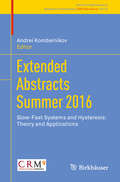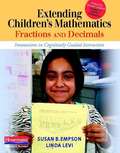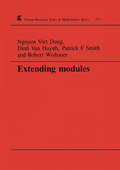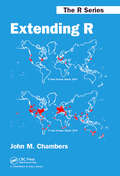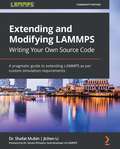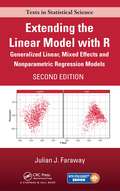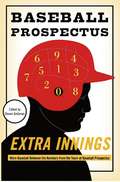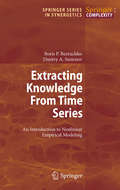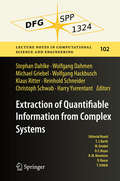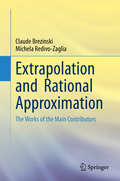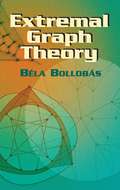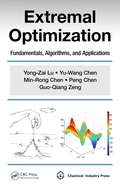- Table View
- List View
Extended Abstracts Spring 2019: Advances in the Anthropological Theory of the Didactic (Trends in Mathematics #13)
by Berta Barquero Ignasi Florensa Pedro Nicolás Noemí Ruiz-MunzónThe book presents research works developed within the Anthropological Theory of the Didactic (ATD) by senior and young researchers that participated in the Intensive Research Program “Advances in the anthropological theory of the didactic and their consequences in curricula and teacher education” held at the Centre de Recerca Matematica (CRM) in Barcelona. It is organized in three axes of current research on the ATD: teacher education and the professionalization of teaching; the curriculum problem in the historical transition from the classical paradigm of visiting works to the emerging didactic paradigm of questioning the world; and research in didactics at the university level.
Extended Abstracts Summer 2015
by Josep Díaz Lefteris Kirousis Luis Ortiz-Gracia Maria SernaThis book is divided into two parts, the first of which seeks to connect the phase transitions of various disciplines, including game theory, and to explore the synergies between statistical physics and combinatorics. Phase Transitions has been an active multidisciplinary field of research, bringing together physicists, computer scientists and mathematicians. The main research theme explores how atomic agents that act locally and microscopically lead to discontinuous macroscopic changes. Adopting this perspective has proven to be especially useful in studying the evolution of random and usually complex or large combinatorial objects (like networks or logic formulas) with respect to discontinuous changes in global parameters like connectivity, satisfiability etc. There is, of course, an obvious strategic element in the formation of a transition: the atomic agents "selfishly" seek to optimize a local parameter. However, up to now this game-theoretic aspect of abrupt, locally triggered changes had not been extensively studied. In turn, the book's second part is devoted to mathematical and computational methods applied to the pricing of financial contracts and the measurement of financial risks. The tools and techniques used to tackle these problems cover a wide spectrum of fields, like stochastic calculus, numerical analysis, partial differential equations, statistics and econometrics. Quantitative Finance is a highly active field of research and is increasingly attracting the interest of academics and practitioners alike. The material presented addresses a wide variety of new challenges for this audience.
Extended Abstracts Summer 2016: Slow-Fast Systems and Hysteresis: Theory and Applications (Trends in Mathematics #10)
by Andrei KorobeinikovThis volume contains extended abstracts outlining selected presentations given by participants of the joint international multidisciplinary workshop MURPHYS-HSFS-2016 (MUltiRate Processes and HYSteresis; Hysteresis and Slow-Fast Systems), which was dedicated to the mathematical theory and applications of multiple scale systems and systems with hysteresis, and held at the Centre de Recerca Matemàtica (CRM) in Barcelona from June 13th to 17th, 2016. The collection includes brief research articles on new results, preliminary work, open problems, and the outcomes of group work initiated during the workshop.The book addresses multiple scale phenomena, singular perturbations, phase transitions, and hysteresis phenomena occurring in mathematical, physical, economic, engineering and information systems. Its scope includes both new results in the theory of hysteresis, singularly perturbed systems and dynamical systems in general; and applications to the physical, chemical, biological, microbiological, economic, and engineering sciences, such as: elasto-plasticity and mechanical structures, damage processes, magnetic materials, photonics and optoelectronics, energy storage systems, hydrology, biology, semiconductor lasers, and shock phenomena in economic modeling. Given its breadth of coverage, the book offers a valuable resource for established researchers, as well as for PhD and postdoctoral students who want to learn more about the latest advances in these highly active research areas.
Extending Children's Mathematics: Innovations In Cognitively Guided Instruction
by Susan B. Empson Linda LeviThis highly anticipated follow-up volume to the landmark Children's Mathematics: Cognitively Guided Instruction addresses the urgent need to help teachers understand and teach fraction concepts. Fractions remain one of the key stumbling blocks in math education, and here Empson and Levi lay a foundation for understanding fractions and decimals in ways that build conceptual learning. They show how the same kinds of intuitive knowledge and sense making that provides the basis for children's learning of whole number arithmetic can be extended to fractions and decimals. Just as they did in Children's Mathematics and Thinking Mathematically, Empson and Levi provide important insights into children's thinking and alternative approaches to solving problems.
Extending Modules (Pitman Research Notes In Mathematics Ser.)
by Nguyen Viet DungModule theory is an important tool for many different branches of mathematics, as well as being an interesting subject in its own right. Within module theory, the concept of injective modules is particularly important. Extending modules form a natural class of modules which is more general than the class of injective modules but retains many of its
Extending R (Chapman & Hall/CRC The R Series)
by John M. ChambersUp-to-Date Guidance from One of the Foremost Members of the R Core Team Written by John M. Chambers, the leading developer of the original S software, Extending R covers key concepts and techniques in R to support analysis and research projects. It presents the core ideas of R, provides programming guidance for projects of all scales, and introduces new, valuable techniques that extend R. The book first describes the fundamental characteristics and background of R, giving readers a foundation for the remainder of the text. It next discusses topics relevant to programming with R, including the apparatus that supports extensions. The book then extends R’s data structures through object-oriented programming, which is the key technique for coping with complexity. The book also incorporates a new structure for interfaces applicable to a variety of languages. A reflection of what R is today, this guide explains how to design and organize extensions to R by correctly using objects, functions, and interfaces. It enables current and future users to add their own contributions and packages to R. A 2017 Choice Outstanding Academic Title
Extending Structures: Fundamentals and Applications (Chapman & Hall/CRC Monographs and Research Notes in Mathematics)
by Ana Agore Gigel MilitaruExtending Structures: Fundamentals and Applications treats the extending structures (ES) problem in the context of groups, Lie/Leibniz algebras, associative algebras and Poisson/Jacobi algebras. This concisely written monograph offers the reader an incursion into the extending structures problem which provides a common ground for studying both the extension problem and the factorization problem. Features Provides a unified approach to the extension problem and the factorization problem Introduces the classifying complements problem as a sort of converse of the factorization problem; and in the case of groups it leads to a theoretical formula for computing the number of types of isomorphisms of all groups of finite order that arise from a minimal set of data Describes a way of classifying a certain class of finite Lie/Leibniz/Poisson/Jacobi/associative algebras etc. using flag structures Introduces new (non)abelian cohomological objects for all of the aforementioned categories As an application to the approach used for dealing with the classification part of the ES problem, the Galois groups associated with extensions of Lie algebras and associative algebras are described
Extending and Modifying LAMMPS Writing Your Own Source Code: A pragmatic guide to extending LAMMPS as per custom simulation requirements
by Dr. Shafat Mubin Jichen Li Dr. Steven PlimptonUnderstand the LAMMPS source code and modify it to meet your research needs, and run simulations for bespoke applications involving forces, thermostats, pair potentials and more with easeKey FeaturesUnderstand the structure of the LAMMPS source codeImplement custom features in the LAMMPS source code to meet your research needsRun example simulations involving forces, thermostats, and pair potentials based on implemented featuresBook DescriptionLAMMPS is one of the most widely used tools for running simulations for research in molecular dynamics. While the tool itself is fairly easy to use, more often than not you'll need to customize it to meet your specific simulation requirements. Extending and Modifying LAMMPS bridges this learning gap and helps you achieve this by writing custom code to add new features to LAMMPS source code. Written by ardent supporters of LAMMPS, this practical guide will enable you to extend the capabilities of LAMMPS with the help of step-by-step explanations of essential concepts, practical examples, and self-assessment questions. This LAMMPS book provides a hands-on approach to implementing associated methodologies that will get you up and running and productive in no time. You'll begin with a short introduction to the internal mechanisms of LAMMPS, and gradually transition to an overview of the source code along with a tutorial on modifying it. As you advance, you'll understand the structure, syntax, and organization of LAMMPS source code, and be able to write your own source code extensions to LAMMPS that implement features beyond the ones available in standard downloadable versions. By the end of this book, you'll have learned how to add your own extensions and modifications to the LAMMPS source code that can implement features that suit your simulation requirements.What you will learnIdentify how LAMMPS input script commands are parsed within the source codeUnderstand the architecture of the source codeRelate source code elements to simulated quantitiesLearn how stored quantities are accessed within the source codeExplore the mechanisms controlling pair styles, computes, and fixesModify the source code to implement custom features in LAMMPSWho this book is forThis book is for students, faculty members, and researchers who are currently using LAMMPS or considering switching to LAMMPS, have a basic knowledge of how to use LAMMPS, and are looking to extend LAMMPS source code for research purposes. This book is not a tutorial on using LAMMPS or writing LAMMPS scripts, and it is assumed that the reader is comfortable with the basic LAMMPS syntax. The book is geared toward users with little to no experience in source code editing. Familiarity with C++ programming is helpful but not necessary.
Extending the Challenge in Mathematics: Developing Mathematical Promise in K-8 Students
by Linda Jensen SheffieldThis guide provides the practical tips and tools educators need to help their mathematically promising students develop their potential to the fullest.
Extending the Linear Model with R: Generalized Linear, Mixed Effects and Nonparametric Regression Models, Second Edition (Chapman & Hall/CRC Texts in Statistical Science)
by Julian J. FarawayStart Analyzing a Wide Range of Problems Since the publication of the bestselling, highly recommended first edition, R has considerably expanded both in popularity and in the number of packages available. Extending the Linear Model with R: Generalized Linear, Mixed Effects and Nonparametric Regression Models, Second Edition takes advantage of the greater functionality now available in R and substantially revises and adds several topics.New to the Second Edition Expanded coverage of binary and binomial responses, including proportion responses, quasibinomial and beta regression, and applied considerations regarding these models New sections on Poisson models with dispersion, zero inflated count models, linear discriminant analysis, and sandwich and robust estimation for generalized linear models (GLMs) Revised chapters on random effects and repeated measures that reflect changes in the lme4 package and show how to perform hypothesis testing for the models using other methods New chapter on the Bayesian analysis of mixed effect models that illustrates the use of STAN and presents the approximation method of INLA Revised chapter on generalized linear mixed models to reflect the much richer choice of fitting software now available Updated coverage of splines and confidence bands in the chapter on nonparametric regression New material on random forests for regression and classification Revamped R code throughout, particularly the many plots using the ggplot2 package Revised and expanded exercises with solutions now included Demonstrates the Interplay of Theory and PracticeThis textbook continues to cover a range of techniques that grow from the linear regression model. It presents three extensions to the linear framework: GLMs, mixed effect models, and nonparametric regression models. The book explains data analysis using real examples and includes all the R commands necessary to reproduce the analyses.
Extensions of Positive Definite Functions
by Palle Jorgensen Steen Pedersen Feng TianThis monograph deals with the mathematics of extending given partial data-sets obtained from experiments; Experimentalists frequently gather spectral data when the observed data is limited, e. g. , by the precision of instruments; or by other limiting external factors. Here the limited information is a restriction, and the extensions take the form of full positive definite function on some prescribed group. It is therefore both an art and a science to produce solid conclusions from restricted or limited data. While the theory of is important in many areas of pure and applied mathematics, it is difficult for students and for the novice to the field, to find accessible presentations which cover all relevant points of view, as well as stressing common ideas and interconnections. We have aimed at filling this gap, and we have stressed hands-on-examples.
Extensions of Rings and Modules
by Jae Keol Park S Tariq Rizvi Gary F. BirkenmeierThe "extensions" of rings and modules have yet to be explored in detail in a research monograph. This book presents state of the art research and also stimulating new and further research. Broken into three parts, Part I begins with basic notions, terminology, definitions and a description of the classes of rings and modules. Part II considers the transference of conditions between a base ring or module and its extensions. And Part III utilizes the concept of a minimal essental extension with respect to a specific class (a hull). Mathematical interdisciplinary applications appear throughout. Major applications of the ring and module theory to Functional Analysis, especially C*-algebras, appear in Part III, make this book of interest to Algebra and Functional Analysis researchers. Notes and exercises at the end of every chapter, and open problems at the end of all three parts, lend this as an ideal textbook for graduate or advanced undergradate students.
Exterior Billiards
by Alexander PlakhovA billiard is a dynamical system in which a point particle alternates between free motion and specular reflections from the boundary of a domain. Exterior Billiards presents billiards in the complement of domains and their applications in aerodynamics and geometrical optics. This book distinguishes itself from existing literature by presenting billiard dynamics outside bounded domains, including scattering, resistance, invisibility and retro-reflection. It begins with an overview of the mathematical notations used throughout the book and a brief review of the main results. Chapters 2 and 3 are focused on problems of minimal resistance and Newton's problem in media with positive temperature. In chapters 4 and 5, scattering of billiards by nonconvex and rough domains is characterized and some related special problems of optimal mass transportation are studied. Applications in aerodynamics are addressed next and problems of invisibility and retro-reflection within the framework of geometric optics conclude the text. The book will appeal to mathematicians working in dynamical systems and calculus of variations. Specialists working in the areas of applications discussed will also find it useful.
Extra Dimensions in Space and Time
by Lawrence Krauss John Terning Farzad Nekoogar Itzhak BarsIn physics, the idea of extra spatial dimensions originates from Nordstöm's 5-dimensional vector theory in 1914, followed by Kaluza-Klein theory in 1921, in an effort to unify general relativity and electromagnetism in a 5 dimensional space-time (4 dimensions for space and 1 for time). Kaluza-Klein theory didn't generate enough interest with physicist for the next five decades, due to its problems with inconsistencies. With the advent of supergravity theory (the theory that unifies general relativity and supersymmetry theories) in late 1970's and eventually, string theories (1980s) and M-theory (1990s), the dimensions of space-time increased to 11 (10-space and 1-time dimension). There are two main features in this book that differentiates it from other books written about extra dimensions: The first feature is the coverage of extra dimensions in time (Two Time physics), which has not been covered in earlier books about extra dimensions. All other books mainly cover extra spatial dimensions. The second feature deals with level of presentation. The material is presented in a non-technical language followed by additional sections (in the form of appendices or footnotes) that explain the basic equations and formulas in the theories. This feature is very attractive to readers who want to find out more about the theories involved beyond the basic description for a layperson. The text is designed for scientifically literate non-specialists who want to know the latest discoveries in theoretical physics in a non-technical language. Readers with basic undergraduate background in modern physics and quantum mechanics can easily understand the technical sections. Part I starts with an overview of the Standard Model of particles and forces, notions of Einstein's special and general relativity, and the overall view of the universe from the Big Bang to the present epoch, and covers Two-Time physics. 2T-physics has worked correctly at all scales of physics, both macroscopic and microscopic, for which there is experimental data so far. In addition to revealing hidden information even in familiar "everyday" physics, it also makes testable predictions in lesser known physics regimes that could be analyzed at the energy scales of the Large Hadron Collider at CERN or in cosmological observations." Part II of the book is focused on extra dimensions of space. It covers the following topics: The Popular View of Extra Dimensions, Einstein and the Fourth Dimension, Traditional Extra Dimensions, Einstein's Gravity, The Theory Formerly Known as String, Warped Extra Dimensions, and How Do We Look For Extra Dimensions?
Extra Innings: More Baseball Between the Numbers from the Team at Baseball Prospectus
by Steven Goldman The Baseball ProspectusIn 1996, a brassy young team of fans produced a guide to baseball statistics. Printed on a photocopier, its distribution, which was in the low hundreds, was limited to friends, family, and die-hard stat heads. Sixteen years later, the Baseball Prospectus annual regularly hits best-seller lists and has become an indispensable guide for the serious fan. In Extra Innings, the team at Baseball Prospectus integrates statistics, interviews, and analysis to deliver twenty arguments about today's game. In the tradition of their seminal book, Baseball Between the Numbers, they take on everything from steroids to the amateur draft. They probe the impact of managers on the game. They explain the critical art of building a bullpen. In an era when statistics matter more than ever, Extra Innings is an essential volume for every baseball fan.
Extracting Knowledge From Time Series: An Introduction to Nonlinear Empirical Modeling
by Boris P. Bezruchko Dmitry A. SmirnovThis book addresses the fundamental question of how to construct mathematical models for the evolution of dynamical systems from experimentally-obtained time series. It places emphasis on chaotic signals and nonlinear modeling and discusses different approaches to the forecast of future system evolution. In particular, it teaches readers how to construct difference and differential model equations depending on the amount of a priori information that is available on the system in addition to the experimental data sets. This book will benefit graduate students and researchers from all natural sciences who seek a self-contained and thorough introduction to this subject.
Extraction of Quantifiable Information from Complex Systems
by Wolfgang Dahmen Stephan Dahlke Michael Griebel Wolfgang Hackbusch Klaus Ritter Reinhold Schneider Christoph Schwab Harry YserentantIn April 2007, the Deutsche Forschungsgemeinschaft (DFG) approved the Priority Program 1324 "Mathematical Methods for Extracting Quantifiable Information from Complex Systems. " This volume presents a comprehensive overview of the most important results obtained over the course of the program. Mathematical models of complex systems provide the foundation for further technological developments in science, engineering and computational finance. Motivated by the trend toward steadily increasing computer power, ever more realistic models have been developed in recent years. These models have also become increasingly complex, and their numerical treatment poses serious challenges. Recent developments in mathematics suggest that, in the long run, much more powerful numerical solution strategies could be derived if the interconnections between the different fields of research were systematically exploited at a conceptual level. Accordingly, a deeper understanding of the mathematical foundations as well as the development of new and efficient numerical algorithms were among the main goals of this Priority Program. The treatment of high-dimensional systems is clearly one of the most challenging tasks in applied mathematics today. Since the problem of high-dimensionality appears in many fields of application, the above-mentioned synergy and cross-fertilization effects were expected to make a great impact. To be truly successful, the following issues had to be kept in mind: theoretical research and practical applications had to be developed hand in hand; moreover, it has proven necessary to combine different fields of mathematics, such as numerical analysis and computational stochastics. To keep the whole program sufficiently focused, we concentrated on specific but related fields of application that share common characteristics and as such, they allowed us to use closely related approaches.
Extrapolation and Rational Approximation: The Works of the Main Contributors
by Claude Brezinski Michela Redivo-ZagliaThis book paints a fresco of the field of extrapolation and rational approximation over the last several centuries to the present through the works of their primary contributors. It can serve as an introduction to the topics covered, including extrapolation methods, Padé approximation, orthogonal polynomials, continued fractions, Lanczos-type methods etc.; it also provides in depth discussion of the many links between these subjects.A highlight of this book is the presentation of the human side of the fields discussed via personal testimonies from contemporary researchers, their anecdotes, and their exclusive remembrances of some of the “actors.” This book shows how research in this domain started and evolved. Biographies of other scholars encountered have also been included. An important branch of mathematics is described in its historical context, opening the way to new developments. After a mathematical introduction, the book contains a precise description of the mathematical landscape of these fields spanning from the 19th century to the first part of the 20th. After an analysis of the works produced after that period (in particular those of Richardson, Aitken, Shanks, Wynn, and others), the most recent developments and applications are reviewed.
Extraterrestrische Maschinen: Auf der Suche nach außerirdischer Intelligenz
by Wilfried DomainkoIn diesem Buch wird die Suche nach extraterrestrischen Strukturen diskutiert, die möglicherweise künstlichen Ursprungs sind. Die Fahndung nach künstlichen, extraterrestrischen Objekten wird jedoch durch die extrem vielfältigen Erscheinungsformen von natürlichen Himmelkörpern erschwert. Trotzdem ist die gezielte Suche nach außerirdischen Maschinen von riesigen Ausmaßen eine Möglichkeit, extraterrestrische Intelligenz zu entdecken. Tatsächlich besteht die Möglichkeit, einige Beobachtungen von außergewöhnlichen Himmelsobjekten entweder im Zusammenhang mit exotischen natürlichen Phänomenen oder aber als solche Technologiesignaturen zu deuten. Extraterrestrische Maschinen könnten technologisch viel fortschrittlicher sein als ihre irdischen Gegenstücke. Im Rahmen des zweiten Erklärungsansatzes könnten modifizierte Sterne als stellare Maschinen dienen, ganze Planeten nach den Bedürfnissen ihrer Bewohner umgestaltet werden oder gigantische Megastrukturen ihre Heimatsterne verdunkeln. Auch in unserem Sonnensystem wären Signaturen von extraterrestrischen Maschinen denkbar. Entsprechend könnten Beobachtungen von einigen sich bewegenden Himmelsobjekten mitunter im Zusammenhang mit interstellaren Raumsonden oder extraterrestrischem Weltraumschrott interpretiert werden. Neben der Vorstellung von möglichen beobachteten Technologiesignaturen und deren natürlichen und künstlichen Erklärungsmodellen, werden in diesem Buch auch verwandte irdische Technikvorhaben mit den entsprechenden Beobachtungen verglichen. In diesem Zusammenhang könnte das Auffinden von extraterrestrischen Maschinen sogar die menschliche Technologieentwicklung verändern.
Extremal Finite Set Theory (Discrete Mathematics and Its Applications)
by Daniel Gerbner Balazs PatkosExtremal Finite Set Theory surveys old and new results in the area of extremal set system theory. It presents an overview of the main techniques and tools (shifting, the cycle method, profile polytopes, incidence matrices, flag algebras, etc.) used in the different subtopics. The book focuses on the cardinality of a family of sets satisfying certain combinatorial properties. It covers recent progress in the subject of set systems and extremal combinatorics. Intended for graduate students, instructors teaching extremal combinatorics and researchers, this book serves as a sound introduction to the theory of extremal set systems. In each of the topics covered, the text introduces the basic tools used in the literature. Every chapter provides detailed proofs of the most important results and some of the most recent ones, while the proofs of some other theorems are posted as exercises with hints. Features: Presents the most basic theorems on extremal set systems Includes many proof techniques Contains recent developments The book’s contents are well suited to form the syllabus for an introductory course About the Authors: Dániel Gerbner is a researcher at the Alfréd Rényi Institute of Mathematics, Hungarian Academy of Sciences in Budapest, Hungary. He holds a Ph.D. from Eötvös Loránd University, Hungary and has contributed to numerous publications. His research interests are in extremal combinatorics and search theory. Balázs Patkós is also a researcher at the Alfréd Rényi Institute of Mathematics, Hungarian Academy of Sciences. He holds a Ph.D. from Central European University, Budapest and has authored several research papers. His research interests are in extremal and probabilistic combinatorics.
Extremal Graph Theory
by Bela BollobasThe ever-expanding field of extremal graph theory encompasses a diverse array of problem-solving methods, including applications to economics, computer science, and optimization theory. This volume, based on a series of lectures delivered to graduate students at the University of Cambridge, presents a concise yet comprehensive treatment of extremal graph theory.Unlike most graph theory treatises, this text features complete proofs for almost all of its results. Further insights into theory are provided by the numerous exercises of varying degrees of difficulty that accompany each chapter. Although geared toward mathematicians and research students, much of Extremal Graph Theory is accessible even to undergraduate students of mathematics. Pure mathematicians will find this text a valuable resource in terms of its unusually large collection of results and proofs, and professionals in other fields with an interest in the applications of graph theory will also appreciate its precision and scope.
Extremal Optimization: Fundamentals, Algorithms, and Applications
by Yong-Zai Lu Yu-Wang Chen Min-Rong Chen Peng Chen Guo-Qiang ZengExtremal Optimization: Fundamentals, Algorithms, and Applications introduces state-of-the-art extremal optimization (EO) and modified EO (MEO) solutions from fundamentals, methodologies, and algorithms to applications based on numerous classic publications and the authors’ recent original research results. It promotes the movement of EO from academic study to practical applications. The book covers four aspects, beginning with a general review of real-world optimization problems and popular solutions with a focus on computational complexity, such as "NP-hard" and the "phase transitions" occurring on the search landscape. Next, it introduces computational extremal dynamics and its applications in EO from principles, mechanisms, and algorithms to the experiments on some benchmark problems such as TSP, spin glass, Max-SAT (maximum satisfiability), and graph partition. It then presents studies on the fundamental features of search dynamics and mechanisms in EO with a focus on self-organized optimization, evolutionary probability distribution, and structure features (e.g., backbones), which are based on the authors’ recent research results. Finally, it discusses applications of EO and MEO in multiobjective optimization, systems modeling, intelligent control, and production scheduling. The authors present the advanced features of EO in solving NP-hard problems through problem formulation, algorithms, and simulation studies on popular benchmarks and industrial applications. They also focus on the development of MEO and its applications. This book can be used as a reference for graduate students, research developers, and practical engineers who work on developing optimization solutions for those complex systems with hardness that cannot be solved with mathematical optimization or other computational intelligence, such as evolutionary computations.
Extremal Polynomials and Riemann Surfaces
by Andrei Bogatyrev Nikolai KruzhilinThe problems of conditional optimization of the uniform (or C-) norm for polynomials and rational functions arise in various branches of science and technology. Their numerical solution is notoriously difficult in case of high degree functions. The book develops the classical Chebyshev's approach which gives analytical representation for the solution in terms of Riemann surfaces. The techniques born in the remote (at the first glance) branches of mathematics such as complex analysis, Riemann surfaces and Teichmüller theory, foliations, braids, topology are applied to approximation problems. The key feature of this book is the usage of beautiful ideas of contemporary mathematics for the solution of applied problems and their effective numerical realization. This is one of the few books where the computational aspects of the higher genus Riemann surfaces are illuminated. Effective work with the moduli spaces of algebraic curves provides wide opportunities for numerical experiments in mathematics and theoretical physics.
Extremal Problems of Analysis and Applications (Synthesis Lectures on Mathematics & Statistics)
by Vladyslav Babenko Volodymyr Kofanov Peter Kogut Oleg Kovalenko Nataliia ParfinovychThis book presents solutions to various extremal problems in analysis and provides mathematical tools that can be used to solve complex problems in different areas of fundamental and applied science. These problems are not just theoretical, but they have practical applications in various fields including optimization and image processing. The book includes an in-depth exploration of Ostrowski type inequalities, covering their applications to operator theory, inequalities for derivatives, and optimization of cubature formulae. The authors also provide a comprehensive treatment of the Bojanov-Naidenov and Erdos problems and investigate their solutions for various function classes including differentiable functions, trigonometric polynomials, and splines. Additionally, the book explores sharp Remez type inequalities. These inequalities are examined in different metrics for various function classes including trigonometric polynomials and splines. The authors also include innovative research in image processing, focusing on the restoration of noise-corrupted optical images with simultaneous contrast enhancement and a variational approach to simultaneous fusion and denoising of color images with different spatial resolutions. This book is a valuable resource for researchers and graduate students in approximation theory, numerical analysis, and image processing.
Extreme Multivalued Waves as a Model of Everything: From Euler Figures to Faraday Waves, Particle-Waves and Universes
by Shamil Usmanovich GalievThe purpose of the book is a mathematical and experimental study of extreme, multivalued waves based on scalar field equations. It is known that Einstein tried to build a unified (interdisciplinary) field theory that would unite all interactions in Nature into a single system. The book uses this idea, supplemented by the idea that all fundamental interactions have a wave, resonant, nonlinear nature. The theoretical foundation of the book also consists of the results of Leonard Euler. Fundamental questions about the polysemy of Nature are considered. On this basis, various highly nonlinear wave processes are modeled, ranging from waves in resonators and ocean waves to descriptions of particle-waves, the origin of the Universe and data from double-slit experiments. Gravitational and inertial effects are associated with solutions of relativistic wave equations. According to the book, the unsolved nature of some fundamental problems in physics is explained by the nonlinear and resonant nature of the world around us, which exists in a non-smooth and inhomogeneous space-time. We do not know how strong the influence of multivalued wave processes on the Universe is. This book is the first attempt to assess this influence. At the same time, the extreme waves considered in this book may be applied to different technologies and systems ranging from the atomic scale to the cosmos. With this book, the author celebrates the 100th anniversary of the beginning of the development of quantum mechanics and modern cosmology.


